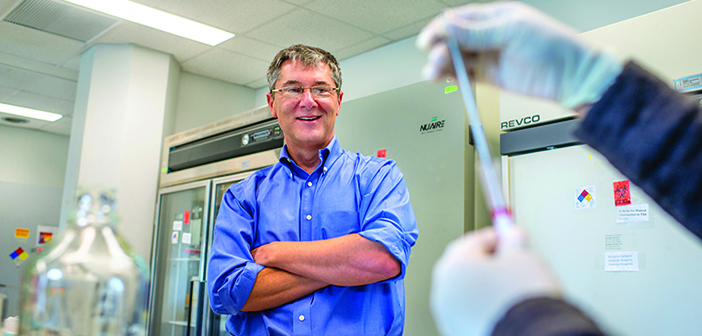Malaria didn’t manage to kill Jake Kurtis. He wants it to stop killing others.
Jonathan “Jake” Kurtis ’89 PhD’95 MD’96 believes in the importance of first exposures. “Your first exposure galvanizes you,” he says. “Everyone who is really serious about global health remembers their first experience.”
Kurtis’s first exposure to what would become his life’s work almost led to his demise. In 1987, during his junior year, the geology-biology concentrator and Rhode Island native was in Kenya researching coral reef ecology. In the dining car of the night train from Nairobi, where he’d been collecting supplies, to Mombasa, where he was staying in a hut on a deserted beach miles from the nearest town, he stumbled on some Americans. Together they threw back several bottles of Tusker, the iconic Kenyan beer. By the time the train pulled into the station the next morning, Kurtis was suffering from fever, massive headache, and some cognitive impairment—signs he had possibly contracted malaria. Somehow he got himself to his hut and collapsed.
“I don’t remember anything that happened for the next three days,” he says, “except when I did wake up, I opened my three foil packs of Fansidar tablets and took them, just as my physician from The Miriam’s pre travel medicine clinic had told me to do if I got sick.”
That physician was G. Richard Olds, MD, an infectious disease doc specializing in tropical diseases, whom Professor of Medicine Charles Carpenter, MD, had recruited to Brown from Case Western in 1983. Carpenter, Olds, and then-Dean David S. Greer, MD, formed the International Health Institute, which Olds directed. When Kurtis returned to Providence, he got his follow-up care from Olds and the two grew close.
But Olds didn’t just save Kurtis’s life. Before long he would also introduce him to his life’s purpose.
The son of a Brown pathology professor and a member of the first PLME cohort, Kurtis was “markedly undirected” as an undergraduate, and he was not exactly loving his medical school years, either. Overwhelmed by what he saw as “too much memorization and not enough science,” he entered what he calls an “intellectual depression.” He confided in Olds that he planned to drop out. Olds convinced him not to, instead urging him to enroll in Brown’s MD/PhD program and work in his lab.
And that was Olds’s third gift, for it was in his lab that Kurtis met and fell in love with Jennifer Friedman, MPH, PhD ’92 MD’96. Then a senior, Friedman was working on schistosomiasis, a devastating disease caused by parasitic worms. The female worm lies inside the male’s gynecophoric canal, Kurtis explains, “so they’re mating 24/7. Jen’s job was ripping apart the male and female worms and looking at their biochemical signal transduction screams of anguish. That threw me into a complete romantic frenzy.”
That experience cemented his love of research. Following a postdoctoral fellowship at Walter Reed Army Institute in Kenya, where he studied malaria vaccine development, Kurtis did his residency in clinical pathology and his fellowship in transfusion medicine, both at the University of Pennsylvania. He returned to Brown in 2000 as an assistant professor in the Department of Pathology and Laboratory Medicine—the very department of which he was appointed chair in July.
Enduring passions
For Kurtis, research was no passing fancy, and neither was Friedman: the couple got married in 1996 and they have three children—and they’re still passionate about protecting people on a large scale from infection and disease. They even started a lab together.
In 2005, armed with $500,000 a year in grants from both the NIH and the Gates Foundation (whose Grand Challenges in Global Health had just put malaria in the crosshairs of the medical and public health communities) and with the help of Lifespan’s then pathologist-in-chief Ron DeLellis, MD ’62, the two physician-scientists moved from the Biomed Center on College Hill to the Pierre Galletti Building in the Jewelry District.

IN THE FIELD: Jake Kurtis (in the blue shirt) walks with Florence Amollo, a health outreach worker, near Ahero, Kenya, in September. They visited villagers to begin community preparation for a new NIH-funded study of his lab’s malaria vaccine candidate. Photo by Kevin Kertscher
Twelve years later, their external funding is in the millions, and their lab—the Center for International Health Research—now houses 10 full-time scientists, not to mention numerous postdocs, grad students, and undergrads. Between them, Kurtis and Friedman are principal investigators on eight NIH grants and two COBRE cores, and have completed or are working on population-based studies in the Philippines, China, Kenya, Tanzania, and Brazil.
Placing themselves squarely between the scientists in Brown’s labs and the clinicians in the affiliated hospitals was no accident. “I think that the questions that we need to ask and answer are at the interface of descriptive epidemiology and very mouse-oriented, basic science,” Kurtis says. “If you’re going to do that, you need to have the language of epidemiology, biostatistics, molecular biology, and immunology. That’s what our team is about. While none of us is an expert in all these disciplines, each member must embrace some kind of common lexicon. You have to have people who are motivated to get out of their academic silos.” Kurtis and Friedman built the center on this philosophical foundation, the conviction that the biomedical discoveries that improve human health occur at the intersection of field and lab science.
Not your grandfather’s pathologist
Following Kurtis around CIHR’s lab space, it’s easy to forget he’s a pathologist. He’s as much a parasite hunter as he is a people person. Though he can rock a Brooks Brothers shirt and trousers as well as the next guy, he’s most comfortable in shorts, a T-shirt, and Keens. His irrepressible boyishness is offset only slightly by the silver in his hair. Ambling among protein purifiers, incubators, fermenters, highspeed multichannel pipetting robots, centrifuges, tissue culture machines, and banks of freezers containing 87,000 samples of human blood and placenta specimens, he pauses to talk to everyone he meets, peppering his often-colorful language with an enthusiastic “Dude!” and offering high fives—including to the undergraduates working there.
“Connection to students is so important,” Kurtis says, “looking them in the eye, understanding how overwhelming it is to be a student. These folks are drinking from a fire hydrant. They’re not going to remember everything you say, regardless of what tools you use, so teach them the one or two critical things that they will remember. You have to make it real for them.” He’s been teaching a long time: even as an MD/PhD student, he served as Olds’s TA for the wildly (and still) popular course UC107, “Burden of Diseases in Developing Countries.” Kurtis travels each year to Grenada to teach for a week at St. George’s University, where Olds is CEO and president. Says Olds: “Last spring, at the end of his week, he got a standing ovation from the students. I don’t get a standing ovation!” Not surprisingly, the Medical School has awarded Kurtis the Dean’s Excellence in Teaching Award at least seven times.
Perhaps because of the life-altering mentorship he received from Olds and others, Kurtis invests deeply in his mentees. One of those is Christian Nixon MD’08 PhD’08, whose thesis (for which Kurtis was the adviser) involved doing the very “DNA gymnastics,” in Kurtis’s words, that revealed the antigen that is key to their vaccine candidate. After earning his MD/PhD from Brown, Nixon went on to complete postdoctoral work at UCSF, Yale, and the Eijkman Institute in Indonesia. Kurtis followed his career closely, finally recruiting him back to Brown in 2014—in a way, replicating Kurtis’s own experience. (They even share a similar
kinetic, buoyant intensity as well as a certain irreverence.)
Nixon is now an assistant professor in the Department of Pathology and Laboratory Medicine and runs a lab at CIHR focused on developing vaccines to prevent transmission of malaria from human to mosquito and identifying new vaccine targets that protect young children from severe disease. “Everyone needs a champion in life,” Nixon says. “Jake was mine.”
Indeed, for all his talk of molecules, antigens, and epidemiology, Kurtis sees himself as a doctor first. “Despite my first impressions during medical school, I actually really enjoy patient contact,” he says. He regrets that as chair, he won’t be able to spend as much time with patients, but he will continue to see them. As associate director of transfusion medicine and coagulation at Rhode Island Hospital (where Nixon is also an attending physician), he takes a very hands-on, even therapeutic role in the management of bleeding, strokes, and clots and the use of anticoagulants and procoagulants.
That focus—on the people who live with and die from disease and not just on the mechanics of it—might explain why, when it comes to exact malaria mortality rates, Kurtis doesn’t really care what statistics the experts in Geneva come up with. A child every minute? Every two? What’s the diff? What matters is the disease is treatable and preventable, and it’s killing kids.
DNA gymnastics
Kurtis and Friedman, CIHR’s director, are waging war against a pair of tropical diseases that hit children especially hard. Friedman, a pediatrician and “card-carrying epidemiologist/biostatistician,” in her husband’s words, has published extensively on schistosomiasis, the world’s second-most devastating parasitic disease, including a recent study showing that the drug praziquantel is a safe and effective treatment for pregnant women.

LAB PARTNERS: Sunthorn Pond-Tor of the Center for International Health Research, left, selects frozen plasma samples from malaria cohort studies for analysis. Photo by David DelPoio
Kurtis has his sights set on malaria—the greatest single agent killer of children on the planet. And while he may not get hung up on numbers, they are pretty dire.
Though it has been eliminated from Western Europe since the 1930s and the US since the 1950s, malaria still threatens almost half the world’s population. The World Health Organization estimates that in 2012, 637,000 people died of malaria, 482,000 of them children. That’s a child a minute. In sub-Saharan Africa and Southeast Asia, it’s a child every 15 seconds.
To Kurtis, this is unconscionable—and not just because we’re talking about dead children. Viewing its ravages at the societal level, he calls the disease a “culling machine” and a “great thumb” keeping entire populations down. Indeed, Martin Edlund, CEO of the nonprofit Malaria No More, has said that ending malaria in the next 25 years would save 11 million lives, prevent 4 billion cases, and result in $2 trillion in economic benefits in the developing world.
Kurtis puts it more succinctly: “Where malaria prospers, people don’t.”
That’s why for him, finding an effective antimalarial vaccine will have global health repercussions on par with the polio vaccine’s. He and others, including pathology and laboratory medicine department colleagues Nixon and Dipak Raj, PhD, and collaborators from the NIH’s National Institute of Allergy and Infectious Diseases, hope they are on their way to doing just that. In 2014, they published a study in Science that showed encouraging results for a novel vaccine candidate.
Malaria is caused by a single-cell parasite transmitted through the bite of an infected female mosquito. Once it enters the body, the parasite migrates to the liver and multiplies 10,000 times, eventually bursting into the bloodstream and infecting red blood cells. While most vaccine candidates are aimed at preventing the parasite from entering the red blood cells, Kurtis and company have identified a protein that prevents it from exiting. The infected cells are then filtered out by the spleen.
This approach didn’t come out of nowhere. It took a decade of collaboration, multidisciplinary expertise, and
those “DNA gymnastics” to get here. It also took what Olds calls Kurtis’s “incredible intellectual tenacity.” The scientists studied a birth cohort of 750 children in Tanzania, where Plasmodium falciparum malaria is endemic. While 94 percent of the children were susceptible to the disease, 6 percent proved resistant, thanks to an antibody they produce that recognizes—and attacks—the protein the parasite needs to escape the red blood cell. This protein is the key to Kurtis’s vaccine, which will address under-5 mortality.
“[They] might still get infected, but [they]won’t die. I’m all for not dead,” Kurtis says. The vaccine is approaching phase 1 human clinical trials; all they need is funding. (Another vaccine candidate is in the pipeline, according to Kurtis, but it’s too soon to talk about it.)
Serious science
Like a gifted polyglot, Kurtis is fluent in many modes of thought, moving easily from the molecular to the organismic to the population level and back again. Similarly, he believes that for an approach to disease eradication to be effective, it must be at once multidisciplinary and translational. That is why he, a pathologist, surrounds himself with epidemiologists, biostatisticians, cell biologists, molecular biologists, and immunologists. It’s also why he, a physicianscientist, wants his department to develop a “balanced portfolio” of basic, translational, and clinical scientists.
“A major powerhouse would be something like 65 to 75 percent master clinicians, 15 percent translation-oriented research clinicians, and 10 to 15 percent NIH-oriented basic science researchers,” he says. “So much low-hanging fruit exists in basic science laboratories, but the results … have not sufficiently translated to new therapies or diagnostics. Pathology is the poster child for moving from the bench to the bedside.” He hopes to add three MD/PhDs to his faculty.
This direction is well aligned with the vision that Dean of Medicine and Biological Sciences Jack A. Elias, MD, has elaborated in his 10-year strategic plan, which aims to turn the Division of Biology and Medicine into a thriving translational medicine enterprise. The recently formed Brown Institute for Translational Science, or BITS, is the cornerstone of that plan. A 2016 gift from The Warren Alpert Foundation of $27 million, most of which is earmarked for reviving Brown’s MD/PhD program—the sine qua non of any medical school that wants to excel in disease-focused translational research—includes $5 million to be used to create BITS’s first endowed professorship. Kurtis is eager for greater collaboration between BITS and Lifespan’s Clinical Research Center, a facility created to support clinical investigators conducting research on experimental therapies therapies and devices. “You can have all the great ideas you want to translate,” he says, “but if you don’t have a place to actually enroll humans, it becomes really hard.”
Kurtis, who now directs the newly named Warren Alpert Physician-Scientist MD/PhD and Advanced Training Program, also wants to make his department’s residency and fellowship programs more research oriented. Expanding the fellowship to three years, for example, two of which would be dedicated to research, would enable fellows to prepare for their academic career while enlarging the department’s “academic footprint.” It would also create a path for turning postdocs into junior faculty, something that’s important to him.
What doesn’t kill us…
Through the plate-glass windows of his office on the third floor of the Galletti Building, Kurtis can gaze southward at the factories-turned-medical facilities of the Jewelry District and eastward, toward College Hill. The views remind him that he sits where the action is when it comes to translating research into cures. Recently named the inaugural Stanley M. Aronson Professor of Pathology and Laboratory Medicine—a professorship endowed by former Chancellor Tom Tisch ’76, P’18, P’20 and Alice Montag Tisch P’18, P’20 in honor of the renowned pathologist and founding dean of Brown’s Medical School—he is nevertheless modest and straightforward about what he’s trying to do: “My job is to put pills in bottles.”
When he thinks about his encounter with—and survival of—malaria, Kurtis takes a rather Nietzschean view. He considers it a boon. “I wondered for years, What is my purpose on the planet? I was turned onto a life’s pursuit at age 20. Most people aren’t lucky enough to have that happen.”




